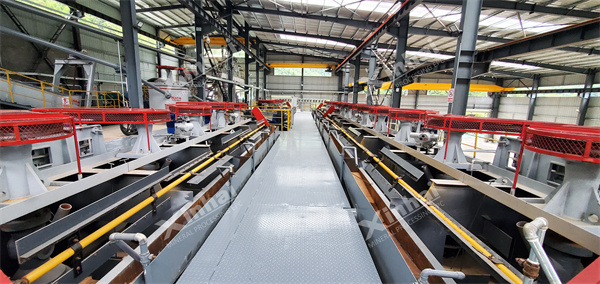Fluorite is mainly used in industries such as steel, non-ferrous metals, and chemical industries. With the continuous mining of fluorite ore, high-grade and easy to concentrate fluorite ore is becoming less and less common, and low-grade fluorite ore has become the main force. So, how to concentrate low-grade fluorite ore? What is the main beneficiation process flow? This article takes a fluorite mine in Inner Mongolia as an example to introduce the beneficiation method and process flow for you.
The main useful mineral in a fluorite mine in Inner Mongolia is fluorite, and the main gangue minerals are quartz and feldspar. According to elemental analysis, the main elements in the fluorite ore are silicon, calcium, aluminum, etc. Among them, the CaF2 content is relatively low, only 29.38%, which is a standard low-grade fluorite ore with a high SiO2 content of 62.18%. In addition, it also contains CaCO3, Al2O3, and S.
The particle size composition of the raw ore is relatively uniform, with a maximum particle size of 150mm and a particle size content of 5.01% for particles larger than 150mm; The particle size content of 150-80mm is 28.55%; The particle size content of 80-20mm is 39.63%, the particle size content of 20-5mm is 20.52%, and the particle size content of<5mm is 6.29%.
(1) Crushing and screening
Crush large pieces of ore with a hammer; Ores smaller than 80mm are crushed to 10mm by a jaw crusher, then crushed to 2mm by a roller crusher, and screened using a vibrating screen with a 2mm mesh. The materials on the screen are returned for re crushing.
(2) Grinding classification
The grinding concentration is 68%, the slurry temperature is 30 ℃, and the grinding fineness test is carried out under the conditions of 600g/oleic acid, 150g/t carboxymethyl cellulose, and 300g/t sodium carbonate. Through experiments, it was found that when the grinding fineness of -200 mesh accounts for 80%, the concentrate grade can reach over 99%, and the recovery rate can reach over 88%. Although the recovery rate can still increase with further fine grinding, the grinding cost will also increase. Therefore, it is determined that the grinding fineness is -200 mesh, accounting for 80%.
The equipment uses a ball mill and a hydraulic cyclone to complete the grinding and classification work.

(3) Flotation
The flotation process consists of a closed circuit process where one coarse and six fine intermediate ores are concentrated and returned to the coarse selection, resulting in two final products: concentrate and tailings. Control the temperature of the slurry at around 30 ℃, add adjusting agent (carboxymethyl cellulose+sodium carbonate) and stir for 3 minutes, then add acid and stir for 3 minutes. Roughly select for 4 minutes, stir for 1 minute before each selection, add adjusting agents before refining for two to four, and the flotation time from one to six is 2 minutes.
In the flotation process, the regulator is carboxymethyl cellulose and sodium carbonate. The carboxymethyl cellulose is prepared into 1% aqueous solution, and the sodium carbonate is prepared into 10% aqueous solution. The dosage is 150g/t and 300g/t respectively. Carboxymethyl cellulose is a substitute for water glass, which can improve concentrate grade and recovery rate due to its low cost.
The collector uses oleic acid, and the amount of oleic acid determined through experiments is 600g/t.
In this case, the low-grade fluorite ore adopts a closed circuit flotation process with one rough selection, six selections, and centralized return of intermediate ore. After flotation, the grade of fluorite concentrate reaches over 98%, and the recovery rate can reach over 88%.
With the continuous improvement of mineral resource utilization, low-grade refractory ores will become the mainstream ore for future beneficiation treatment, and traditional beneficiation methods are difficult to ensure their effectiveness. At this point, a professional design team should design a dedicated beneficiation process flow. Xinhai Mining Equipment has a beneficiation design institute, which can conduct beneficiation tests on ore samples provided by customers. Based on the test results, the beneficiation process is formulated to ensure one ore, one plan, and to refuse to copy or apply, ensuring full resource recovery.